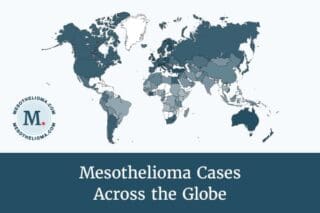
Nicholas Hondrogen was a true artist, applying his creative energy to a number of mediums throughout his career. Since his days in art school, Hondrogen showed his highly ambitious nature. Though his program at Boston’s School of the Museum of Fine Arts was meant to span the course of five years, after some encouragement from Flemish artist Jan Cox, Hondrogen completed his education in just two years.
While going through the program himself, Hondrogen was teaching others in painting, lithography, and other mediums, as well as working on outdoor murals around Boston. After his graduation, Hondrogen moved to Paris to start his solo career and very quickly found success. As he made his mark through his exhibitions and painting, and even turning his focus to filmmaking, the artist didn’t realize that past asbestos exposure was taking its toll.
Asbestos in the Art Studio
Hondrogen first moved to Paris in 1972, working from a tiny studio above a garage. He renovated the space to make it more functional for his needs, and the paintings he produced throughout this period brought him rapid success in Europe. Hondrogen enjoyed many solo exhibitions, with his works quickly being collected by individual art lovers and public institutions alike, including the Museum of Modern Art of the City of Paris.
In the 1980s, he returned to the United States, settling into New York City. Working in another studio he had renovated, Hondrogen continued to create paintings, photographs, and even started getting into filmmaking. In 1982, he even received an American Film Institute Grant for film production. He soon moved to Los Angeles to turn his focus on film and production.
One of his most notable works today remains his film, Perfect Moment, from 1997. The film focused on a variety of people, famous and otherwise, including Larry King, Philip Glass, veterans, and the homeless. Each individual was asked “If you were about to die, what moment would you remember most?” The film was submitted to the Slamdance International Film Festival and ultimately won Best Feature Documentary film against over a thousand entries. After his film, Hondrogen remained in California but returned his focus to painting, creating several notable series and receiving a Pollock Krasner grant for painting in 2000.
But while his career continued to flourish in a variety of mediums, Hondrogen was unknowingly facing the severe health threats that follow asbestos exposure. In his small studios in both Paris and New York City, he likely was exposed to the toxin as renovations occurred. Asbestos was widely used in construction for decades around the world, especially from the 1940s to the 1970s. Asbestos was banned in France in 1997, but still remains legal in limited quantities in the United States today.
Being unaware of the presence of asbestos during renovations is especially dangerous. Though the mineral is technically innocuous when left undamaged, any kind of construction projects, damage, or everyday wear and tear can easily disturb or damage any building materials containing the toxin. As a result, fibers may release into the air and put anyone who spends time in the space, like Hondrogen’s studios, at risk of inhaling or ingesting the fibers. Over time, the fibers can cause damage to the lining of various organs and develop into tumors, causing mesothelioma.
Diagnosed with Peritoneal Mesothelioma
Not long after receiving his second Pollock Krasner painting grant and developing several well-received collections, the health impacts of his exposure in the 1970s and 1980s became more prevalent. In 2005, Hondrogen was diagnosed with malignant peritoneal mesothelioma, which develops in the abdominal cavity and is the second most common form of the disease.
In recent years, survival rates for peritoneal mesothelioma have been improving thanks to some treatment advancements, such as a heated chemotherapy wash (HIPEC) in combination with surgery. Though this treatment has prolonged survival for many patients, surgery isn’t always an option for those diagnosed at a later stage. For many of these patients, palliative treatment to manage symptoms rather than try to cure the disease may be the only option they have.
Mesothelioma is rather aggressive, and can quickly spread in the body, giving many patients limited treatment options. On average, peritoneal mesothelioma patients have a prognosis of just 6 – 12 months. With these newer treatments, about 92% of patients survive at least one year after diagnosis.
Facing his diagnosis, Hondrogen and his family moved back to Massachusetts, settling in Amherst. Despite his health, Hondrogen still worked in a nearby studio and continued to paint as much as he was able. As his mesothelioma got worse, he moved into a hospice near his studio to help better manage his symptoms and have a better quality of life. After a two-year battle with peritoneal mesothelioma, Hondrogen passed away on February 28.
An Artistic Legacy
Following his death in 2007, Hondrogen’s patrons and loved ones came together to create the Nicholas Hondrogen Trust. Though his career was cut short, the fund continues to grow his reputation in the art world today.
Asbestos continues to claim lives all over the world, even in countries where it was banned many years ago. The toxin’s impact won’t go away any time soon, especially considering the long latency period before diseases like mesothelioma begin to show. Until further action is taken to ban the mineral on a global scale and also increase abatement efforts to protect the public, mesothelioma and these other asbestos-caused diseases will persist.
Main photo: FRACTAL ELLIPSE No. 30, (Le Deluge) 2004, 90″ x 145″ oil and wax on styrene mounted on Balitic plwood




